Tehran's Iranian Garden | Tehran's Persian Paradise
Serving as a serene oasis in the heart of the bustling city, the Iranian Garden in Tehran offers respite from urban chaos.
Its historical roots run deep, tracing back to the illustrious Qajar period, where it belonged to the influential Mostofi-ul-Mamalek family. What sets this garden apart are its unique features, from ancient trees dating back centuries to meticulously landscaped green spaces. Visitors are greeted with a sense of tranquility as they wander through its pathways, immersing themselves in the beauty and history of this must-visit destination.
Interested in visiting Tehran's Iranian Garden?
Check out our Tehran tour packages to find an itinerary that includes visiting the garden
or...
Design your own tailor-made itinerary and include Tehran's Iranian Garden in it by yourself, today!
History of Persian Gardens
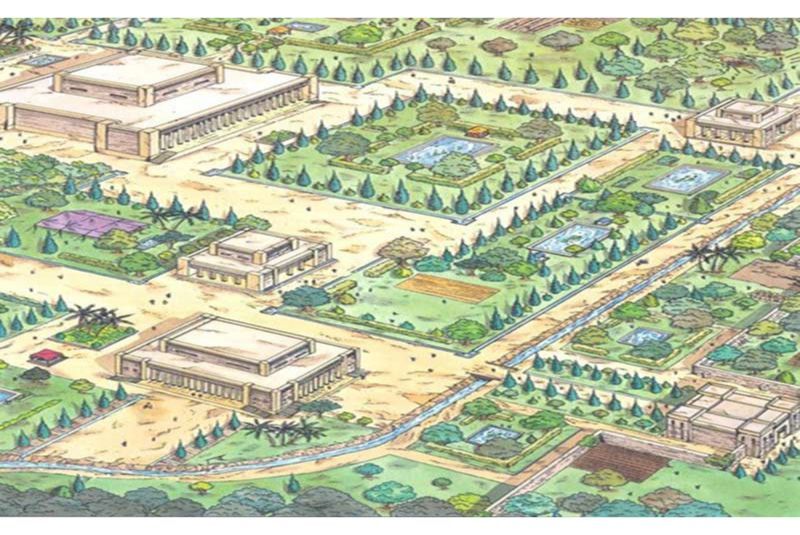
Persian gardens boast a storied history dating back millennia, rooted in the ancient civilizations that once flourished in the region. These gardens are not merely horticultural marvels but intricate reflections of Persian culture, philosophy, and aesthetics. The earliest known examples date back to the Achaemenid period, with Pasargad's gardens attributed to Cyrus the Great. These gardens were not just places of beauty but symbols of power and prestige, showcasing the wealth and sophistication of Persian rulers.As Persian civilization evolved, so too did its gardens. The Sassanid dynasty further refined garden design, introducing elements like elaborate water features, lush vegetation, and symmetrical layouts. These gardens served as retreats for royalty and nobility, offering respite from the pressures of court life and the harsh desert environment.
Persian Gardens Architecture
Central to the allure of Persian gardens is their architectural elegance and structural ingenuity. At the heart of these gardens lies a grand mansion or pavilion, serving as a focal point and gathering place for guests. Surrounding this central structure are meticulously landscaped grounds, carefully divided into geometric patterns and lush greenery.
Water plays a central role in Persian garden design, with flowing streams, fountains, and pools creating a sense of serenity and coolness. These water features not only serve aesthetic purposes but also provide practical benefits, such as irrigation and climate control.
Surrounding the central mansion are high walls, serving to enclose the garden and create a sense of seclusion and intimacy. These walls also act as protective barriers, shielding the garden from outside noise and disturbances. Within these tranquil confines, visitors can immerse themselves in the sights, sounds, and scents of nature, finding solace and rejuvenation amidst the hustle and bustle of city life.
| Related: Iranian Art Museum Garden - Tehran Miniature Marvel
The Iranian Garden in Tehran

Layout and Architecture
The Iranian Garden in Tehran is a masterpiece of Persian garden design, boasting an intricate layout that seamlessly blends architectural elegance with natural beauty. As visitors meander through its winding pathways, they are enveloped in a sense of serenity and tranquility. Each turn reveals new vistas, from lush greenery to tranquil ponds reflecting the azure sky above.
One of the most striking features of the Iranian Garden is its ornate pavilions, which serve as focal points throughout the garden. These architectural marvels are adorned with intricate tilework and elegant archways, transporting visitors to a bygone era of Persian grandeur. Whether seeking shade from the sun or a quiet spot for contemplation, the pavilions offer a welcome respite amidst the verdant landscape.
Tranquil ponds dot the Iranian Garden, providing a sense of calm and reflection amidst the bustling city. Lined with fragrant flowers and bordered by towering trees, these ponds are havens for wildlife and visitors alike. The sound of trickling water adds to the ambiance, creating a soothing soundtrack for leisurely walks and quiet moments of contemplation.
The layout and architecture of the Iranian Garden in Tehran are a testament to the ingenuity and artistry of Persian garden design. Each element is carefully curated to evoke a sense of harmony and tranquility, inviting visitors to immerse themselves in the timeless beauty of this cultural gem.
| Related: Elements of Persian Architecture
Botanical Diversity
The Iranian Garden in Tehran boasts a rich tapestry of botanical diversity, showcasing a wide array of trees, flowers, and plants that contribute to its vibrant ambiance year-round. Visitors to the garden are treated to a sensory feast as they wander among the diverse flora, each species offering its own unique colors, textures, and fragrances.
Among the towering trees that grace the landscape are majestic plane trees, providing shade and shelter from the sun's rays. Tall cypresses stand sentinel throughout the garden, their slender forms adding vertical interest to the lush surroundings. Fragrant roses perfume the air with their delicate scent, while vibrant flowers such as tulips and daffodils add pops of color to the verdant landscape.
Throughout the seasons, the Iranian Garden undergoes a transformation as different species come into bloom. Spring brings a riot of color as tulips and daffodils carpet the ground, while summer sees the garden bursting with the vibrant hues of roses and other flowering plants. In autumn, the leaves of the trees turn golden and russet, casting a warm glow over the landscape, while winter brings a quiet beauty as the garden rests beneath a blanket of snow.
The botanical diversity of the Iranian Garden adds depth and richness to its natural beauty, ensuring that visitors are enchanted by its charms regardless of the time of year.
| Discover: Negarestan Garden in Tehran
Historical Evolution of the Iranian Garden in Tehran
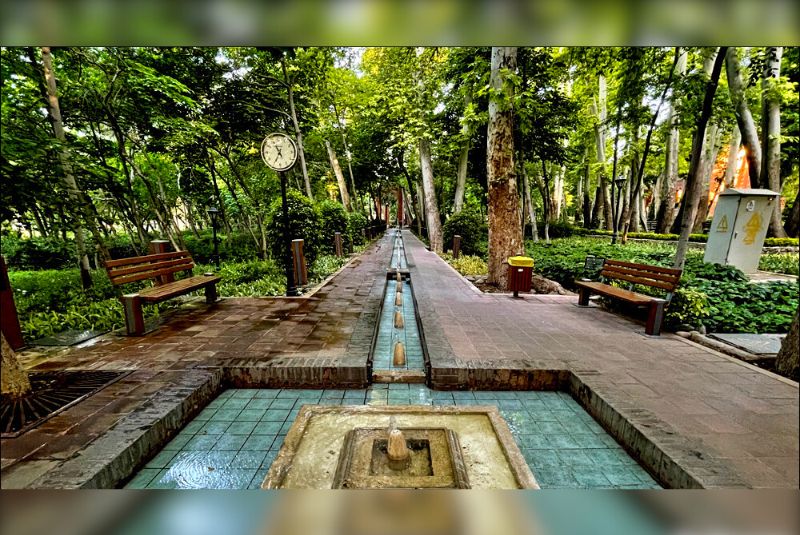
The Iranian Garden in Tehran has undergone a remarkable transformation over the centuries, reflecting the rich tapestry of Persian history and culture. Originally part of the Mustofi garden complex during the Qajar period, the garden belonged to the influential Mostofi-ul-Mamalek family. Their legacy is deeply ingrained in Iranian history, with roots tracing back to Mirza Hasan Khan Mostofi-ul-Mamalek, who inherited the garden from his father, Mirza Yousef Khan Mostofi.
Under Mirza Hasan's stewardship, the garden flourished, becoming a cherished retreat for relaxation and contemplation. It served as a testament to the family's prominence in Iranian society, with its sprawling mansion and meticulously landscaped grounds.
In the modern era, the Iranian Garden underwent a revitalization under the care of Ali Mehtari Mokhtari. Preserving its original charm while incorporating elements of traditional Persian garden design, Mokhtari transformed the garden into a spectacular destination for locals and tourists alike.
In recognition of its historical and cultural significance, the Iranian Garden was designated as a national heritage site in 2002. Today, it stands as a testament to centuries of Persian history and culture, offering visitors a glimpse into the rich tapestry of Iran's past. From its humble origins as part of the Mustofi garden complex to its status as one of Tehran's must-see attractions, the Iranian Garden continues to captivate and inspire all who wander through its verdant grounds.
| Related: Jamshidieh Stone Garden
Tehran's Iranian Garden Key Attractions
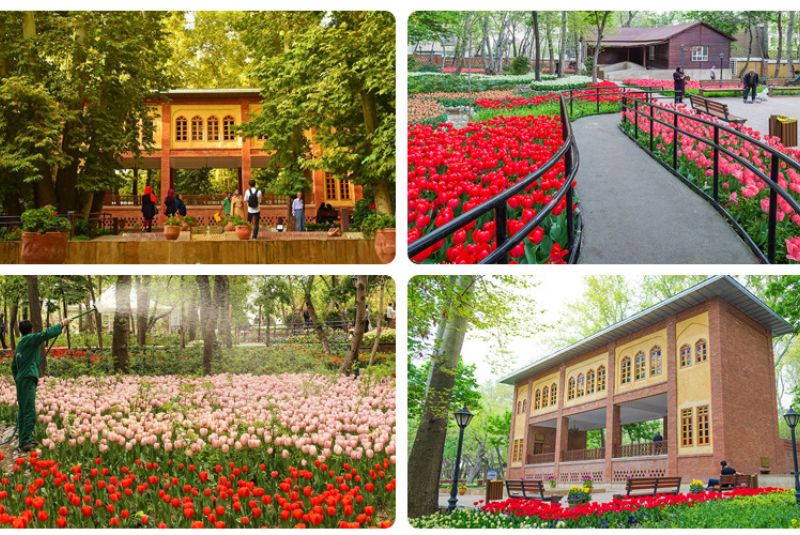
The Iranian Garden in Tehran is replete with captivating attractions that beckon visitors to explore its cultural significance. Among the must-see highlights are the Kushk, the library, and the vibrant tulip displays.
The Kushk, once a bustling cafe and restaurant, now stands as a serene retreat within the garden. Its ornate architecture and tranquil atmosphere offer visitors a glimpse into the garden's historical charm, providing a peaceful oasis for relaxation and contemplation.
Adjacent to the Kushk is the garden's library, a treasure trove of literary delights. Here, visitors can delve into the garden's rich history and cultural heritage, immersing themselves in books and manuscripts that shed light on its storied past.
Finally, the Iranian Garden is renowned for its vibrant tulip displays, which bloom from late April to mid or late May. These colorful blooms add a burst of color to the landscape, creating a breathtaking spectacle that attracts visitors from far and wide. Each of these attractions offers unique insights into the Iranian Garden's cultural significance, inviting visitors to explore its hidden treasures and discover the rich tapestry of Persian history and culture that lies within.
| Read more: Tehran National Garden Gate - Sardar-e Bagh-e Melli
Tehran's Iranian Garden Visitor Experiences
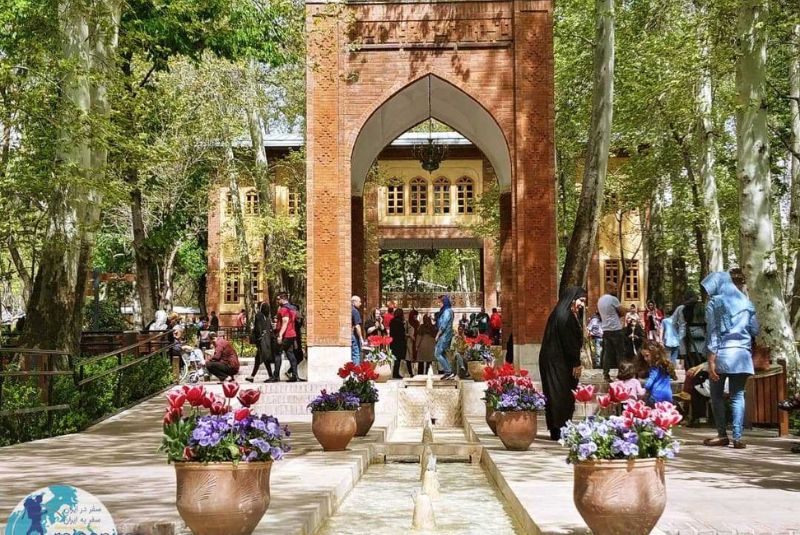
Visitors to the Iranian Garden in Tehran are treated to a myriad of experiences that cater to both relaxation and exploration. Situated on Sheikh Bahai North Street, approximately 20 meters from Pirozan, Shahid Saberi Alley, the garden offers a tranquil retreat amidst the bustling cityscape. Many choose to start their journey with leisurely strolls along the garden's winding pathways, immersing themselves in the tranquility of the surroundings. As they meander through the lush greenery and admire the architectural marvels, they are enveloped in a sense of peace and serenity.
For those seeking panoramic views of the city, the western entrance of the Iranian Garden offers a perfect vantage point. From here, visitors can gaze out over parts of the bustling metropolis of Tehran, taking in the sights and sounds of the city below. It's a breathtaking perspective that highlights the juxtaposition of nature and urban life.
Others may opt to spend their time exploring the garden's various attractions, such as the Kushk and library, which offer unique insights into the garden's cultural significance. Whether enjoying a quiet moment of reflection by the tranquil ponds or marveling at the vibrant tulip displays, there's something for everyone to enjoy at the Iranian Garden location in Tehran.
The Iranian Garden promises a memorable experience for all who visit, with its blend of natural beauty, historical charm, and cultural significance. Whether you're a local resident or a tourist exploring Tehran for the first time, a visit to the Iranian Garden is sure to leave a lasting impression.
| Also read about: Tehran Book Garden
Famous Persian Gardens
Pasargad
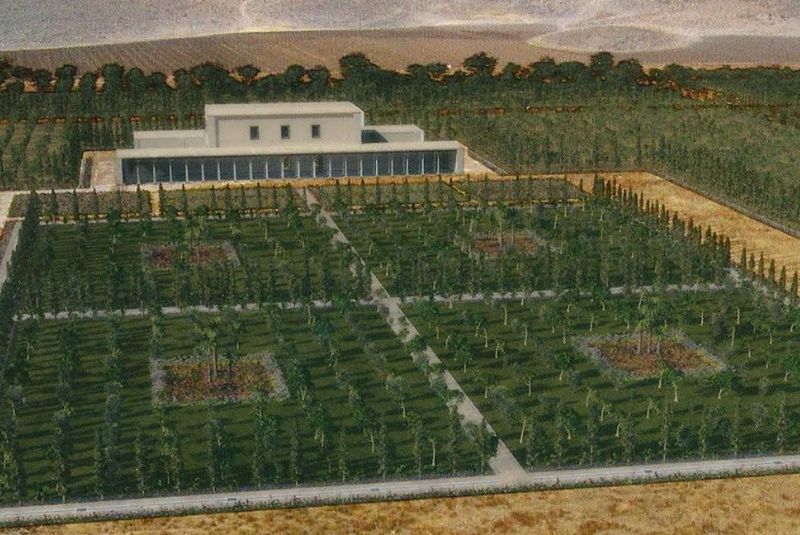
Among the most revered Persian gardens is Pasargadae, dating back to the time of Cyrus the Great, the founder of the Achaemenid Empire. This UNESCO World Heritage Site is renowned for its expansive layout and sophisticated irrigation systems. Its architectural features, including the Tomb of Cyrus, exemplify the fusion of Persian and Mesopotamian design elements. Pasargad holds immense cultural importance as the resting place of Cyrus the Great and symbolizes the birth of Persian civilization.
Shazdeh Mahan
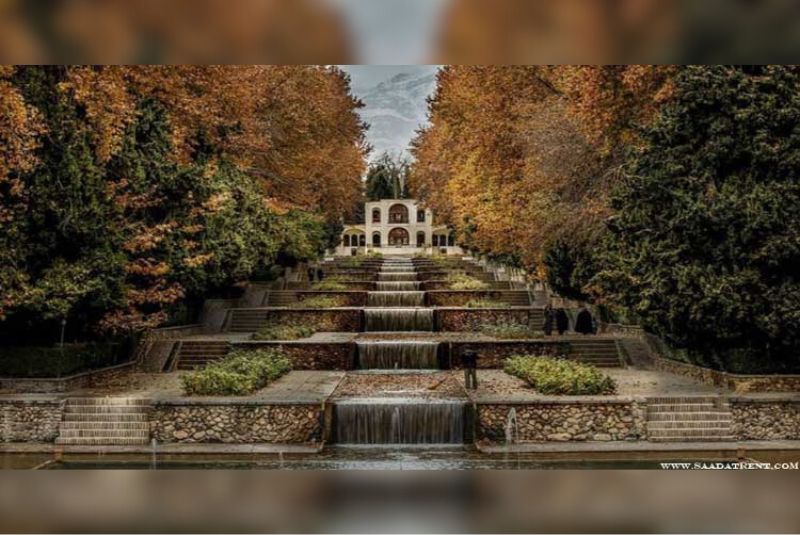
Nestled in the heart of Kerman province, Shazdeh Mahan Garden is a testament to the ingenuity of Persian garden design. Constructed during the Qajar era, this paradise boasts terraced landscapes, cascading waterfalls, and ornate pavilions. Its architectural features, such as the intricate tilework and elegant archways, reflect the opulence of the era. Shazdeh Mahan served as a retreat for royalty and dignitaries, offering a serene escape from the desert heat and a showcase of Persian artistic mastery.
Eram Garden
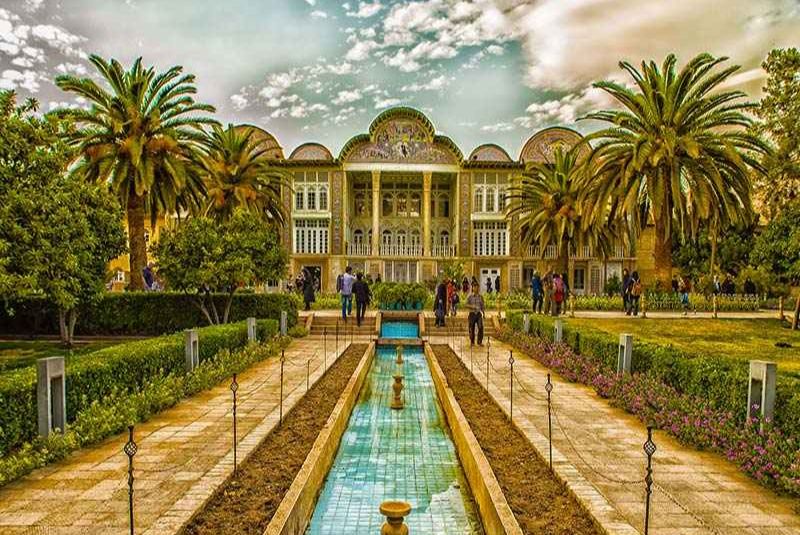
Eram Garden in Shiraz epitomizes the poetic beauty of Persian gardens, with its lush greenery, fragrant flowers, and tranquil water features. Originally built during the Seljuk period, the garden was later expanded and embellished by various rulers, including the Qajars. Its iconic Cypress Avenue, adorned with towering trees, creates a sense of grandeur and symmetry. Eram Garden has long been a source of inspiration for poets and artists, embodying the essence of Persian culture and spirituality.
These gardens, along with many others scattered across Iran, stand as testaments to the enduring legacy of Persian garden design. Their architectural splendor, cultural significance, and historical importance continue to captivate visitors from around the world, offering glimpses into Iran's rich heritage and artistic heritage.
Finally!
Tehran's Iranian Garden stands as a timeless symbol of Persian elegance and tranquility. With its rich history, intricate architecture, and vibrant botanical diversity, the garden offers visitors a captivating glimpse into Iran's cultural heritage. As a cultural and historical landmark, it serves as a testament to centuries of Persian ingenuity and artistic expression. I encourage readers to embark on their own journey of discovery and immerse themselves in the beauty and serenity of this iconic Persian oasis. Whether exploring its winding pathways, admiring its ornate pavilions, or simply enjoying the vibrant tulip displays, the Iranian Garden promises an unforgettable experience for all who visit.
Share your story!
Comment below and let us know about your Experience.
Your story inspires others!


Comment
Leave a Comment